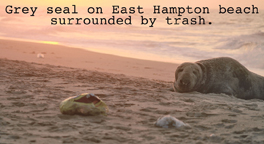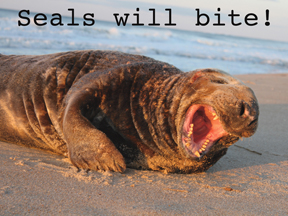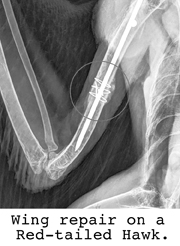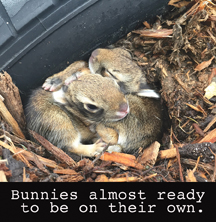
May 2020: When Do I Help?

Happy spring once again folks. Summer is just a step ahead and we’re all still wondering when our country will get this COVID-19 pandemic under control. Our community was given direction on how to best deal with the spread of the virus and how to protect ourselves and each other. After an unexpected exodus from NYC, the influx of summer residents and guests arrived here very early and personally, I feel it unbalanced our community’s safety net. Not only do I see the safety rules being ignored everywhere I look, but the trash and garbage all over the grounds, roadsides and shorelines is disgusting and a sign that many folks have collectively lost touch with their responsibility to OUR SHARED environment. Ironically, the very items we use to protect ourselves (latex gloves and face masks), we throw on the ground, literally destroying our environment. And from a wildlife stand-point, our discarded filth poisons and kills them as well.
So, here I am writing my monthly column on how we can do better for our beautiful wildlife, and it’s becoming more evident that we don’t even care about each other, our environment, our future, our children’s future and in some cases even ourselves. I take great offense to this behavior because THEIR negligence puts ME at risk and also my friends and family who do follow the proper guidelines, and are trying to do everything we can to stay healthy and safe, and get this pandemic under control. Be smart people, and if you see someone not following the safety guidelines, perhaps you can remind them that their choice to ignore the rules are affecting EVERYONE, and risking other people’s lives including yours.
 Now that I got that off my chest, I’d like to continue talking about what you should and shouldn’t do when you come across wildlife, or in the case of my first subject species, marine life. I think we need a huge billboard erected at each beach entrance, “PLEASE LEAVE THE SEALS ALONE – $1000 FINE” Another grand example of folks completely ignoring guidelines, rules and laws. In this case FEDERAL LAW. Seals, like all marine mammals are federally protected and are to be left alone at ALL times. These laws are in place for a number of reasons, but basically it’s to protect both the animal and the general public. Ignoring the 150′ law is no different than ignoring any other federal law, it’s just much more difficult to get caught violating it. But you really wouldn’t get that vibe if you frequent social media, as there are a lot of posts showing folks getting very close and even some taking selfies right next to the seals.
Now that I got that off my chest, I’d like to continue talking about what you should and shouldn’t do when you come across wildlife, or in the case of my first subject species, marine life. I think we need a huge billboard erected at each beach entrance, “PLEASE LEAVE THE SEALS ALONE – $1000 FINE” Another grand example of folks completely ignoring guidelines, rules and laws. In this case FEDERAL LAW. Seals, like all marine mammals are federally protected and are to be left alone at ALL times. These laws are in place for a number of reasons, but basically it’s to protect both the animal and the general public. Ignoring the 150′ law is no different than ignoring any other federal law, it’s just much more difficult to get caught violating it. But you really wouldn’t get that vibe if you frequent social media, as there are a lot of posts showing folks getting very close and even some taking selfies right next to the seals.
 This leads me to a question I have for our local law enforcement; if I posted a photo on social media of me violating a federal law, why would I not be charged for violating that federal law? There is one video that has seemed to go viral of two folks literally pestering a seal while trying to get up close for a cell phone photo. It was taken on one of our local beaches. Look, I’m no genius, but the fact that nothing is ever done about this constant breech of federal law, clearly is the motivation for others to continue disobeying it. Otherwise this issue would have been addressed and taken care of years ago. Our seals are disturbed by humans almost EVERY DAY. I know this first hand because I get the multiple calls EVERY DAY. And it will continue to happen and get worse until the law is enforced. If folks keep seeing social media posts showing it’s ok, and there is no recourse to breaking federal law, then of course it’s going to continue and get worse. Our community leaders need to step up and stop ignoring this very important issue year after year.
This leads me to a question I have for our local law enforcement; if I posted a photo on social media of me violating a federal law, why would I not be charged for violating that federal law? There is one video that has seemed to go viral of two folks literally pestering a seal while trying to get up close for a cell phone photo. It was taken on one of our local beaches. Look, I’m no genius, but the fact that nothing is ever done about this constant breech of federal law, clearly is the motivation for others to continue disobeying it. Otherwise this issue would have been addressed and taken care of years ago. Our seals are disturbed by humans almost EVERY DAY. I know this first hand because I get the multiple calls EVERY DAY. And it will continue to happen and get worse until the law is enforced. If folks keep seeing social media posts showing it’s ok, and there is no recourse to breaking federal law, then of course it’s going to continue and get worse. Our community leaders need to step up and stop ignoring this very important issue year after year.
With that said, let me address a few more items that are unnecessarily reported and often misunderstood by folks who come across a seal and think it’s in distress. Just getting folks to understand that seals are SEMI-AQUATIC and what that means, is an ongoing effort. At least a half dozen times a day I explain to folks that semi-aquatic means exactly what it says; that these animals often spend as much time on land as they do in the water, particularly when they give birth. Therefore, if you see a seal pup beached on the sand or rocks, that rarely indicates it’s in distress. In fact, it’s completely normal.
Another common sight when coming upon a seal hauled out onto the beach, is blood or minor injuries visible on the seal. This applies to both young and old, but more often on the adults. To someone who is unfamiliar with seals might determine this as a sign of the animal needing immediate help; however, in most cases it’s much less serious, and again common. I often ask folks to imagine the perils of living in the ocean; rough and stormy seas from time to time, larger and unfriendly predators, confrontations with other seals, hauling out onto rocks or rocky shorelines on your belly, etc., etc. After which most folks can more easily understand why a seal might be a bit banged up when observed onshore.
There will however, be times when a seal might actually be in distress, and even require human intervention to survive, but there is one major stipulation to be followed in this case; the only folks permitted to approach and handle/help an injured seal is the folks at the NYS Marine Rescue Center, formally the Foundation for Marine Rescue & Research located in Riverhead. These are the absolute ONLY people who can lawfully respond and help distresses marine mammals. There are no exceptions unless THEY permit it, and they rarely do. These people are highly trained in handling marine mammals, particularly pinnipeds (seals), and know all the safety and regulatory precautions necessary to help them in times of distress. Marine mammals differ from our terrestrial species in terms of health issues and diseases because they share both land and sea as their habitat. PLEASE FOLKS, leave the seals alone.
 Birds with broken wings are another issue that folks can easily get confused about when wondering how to help. A broken wing is usually indicated by loss of flight or the broken wing literally dragging by the distressed animal’s side. A broken wing usually means the bird will need to be put down, simply because the bird’s quality of life is severely compromised. If the bird cannot fly, it loses much of its survival functions like traveling, evading predators, finding or catching food, etc. Therefore, it’s often advised that these injured birds be euthanized; however, there are certain breaks that can be repaired. Wing bones generally heal quickly (if the bone isn’t too badly broken) and in just a couple weeks could be strong enough for flight. The worst case would be an open fracture where the bone breaks through the skin. These breaks almost never heal properly. It’s also difficult for a broken bone to mend that is positioned above the elbow. The more survivable breaks are usually those of the radius bones. These are also the most common wing breaks, so until an X-ray is taken to locate the actual break, the bird is considered a patient worth saving. It is therefore recommended that folks who come across an injured bird with a broken wing, to be extra careful handling the bird as to not allow the break to become worse or break the skin. Secure the wings of the bird gently to the bird’s side using a towel or veterinarian tape (which does not stick to the feathers). Then transport the bird to your local vet, animal hospital or wildlife rehabilitation center.
Birds with broken wings are another issue that folks can easily get confused about when wondering how to help. A broken wing is usually indicated by loss of flight or the broken wing literally dragging by the distressed animal’s side. A broken wing usually means the bird will need to be put down, simply because the bird’s quality of life is severely compromised. If the bird cannot fly, it loses much of its survival functions like traveling, evading predators, finding or catching food, etc. Therefore, it’s often advised that these injured birds be euthanized; however, there are certain breaks that can be repaired. Wing bones generally heal quickly (if the bone isn’t too badly broken) and in just a couple weeks could be strong enough for flight. The worst case would be an open fracture where the bone breaks through the skin. These breaks almost never heal properly. It’s also difficult for a broken bone to mend that is positioned above the elbow. The more survivable breaks are usually those of the radius bones. These are also the most common wing breaks, so until an X-ray is taken to locate the actual break, the bird is considered a patient worth saving. It is therefore recommended that folks who come across an injured bird with a broken wing, to be extra careful handling the bird as to not allow the break to become worse or break the skin. Secure the wings of the bird gently to the bird’s side using a towel or veterinarian tape (which does not stick to the feathers). Then transport the bird to your local vet, animal hospital or wildlife rehabilitation center.
Another question I’m asked when folks find an injured or distressed animal is, “should I give it food and water?” My answer is usually NO! First reason is most folks don’t know what is proper food for said animal and I cringe when I’m told that, “I just gave the injured deer some of my pizza from dinner because it looked hungry”. I also don’t recommend giving an animal dairy milk, unless that animal is a calf. Rehabbers will worry about the feedings and hydration, therefore folks who find distressed / injured wildlife should concentrate on getting said animal to a vet or rehab facility. In a lot of cases dehydration IS the problem, or in many cases an additional problem created by a larger problem. For that reason hydration MAY BE necessary if the person helping the animal keeps the animal overnight for observation. Depending on the type and age of the distressed animal, this will usually require a bottle or syringe with the appropriate nipple. The variety of choices could be overwhelming, so it’s best to contact a rehabilitator who can recommend the proper equipment, answer questions and guide you through the process. Every rehabilitator I’ve ever known has been more than happy to help others who do wildlife home care and to answer any question. As I mentioned last month, we on the east end of Long Island are very fortunate to have a huge wildlife rescue / rehab presence with both nonprofit organizations dedicated to the field and individuals dedicated to helping, usually volunteering to helping these organizations or the wildlife specifically, on their own. It’s a beautiful thing. If you happen to find an injured, orphaned or distressed animal and you don’t know what you’re doing, DO NOT GUESS and try to raise the animal your way. That almost always ends in a painful death to the animal.
 One more important one, baby rabbits. Those who come across, or their dog comes across baby rabbits in a shallow depression covered under the tall grass, should at all cost, leave them alone and wait it out. First, it’s very difficult to rehabilitate / nurse hairless baby rabbits and is best accomplished by mom herself. Secondly, rabbits grow very fast and letting the rabbits relocate on their own doesn’t normally take too long at all. Bunnies that are tiny and fully covered in hair are much easier; however, as soon as the bunny’s eyes open and they leave the den, they are absolutely capable of surviving on their own.
One more important one, baby rabbits. Those who come across, or their dog comes across baby rabbits in a shallow depression covered under the tall grass, should at all cost, leave them alone and wait it out. First, it’s very difficult to rehabilitate / nurse hairless baby rabbits and is best accomplished by mom herself. Secondly, rabbits grow very fast and letting the rabbits relocate on their own doesn’t normally take too long at all. Bunnies that are tiny and fully covered in hair are much easier; however, as soon as the bunny’s eyes open and they leave the den, they are absolutely capable of surviving on their own.  Of course they are vulnerable because of their age and size, but in the wild, that’s how it works. In fact mom will often send them packing shortly after emerging from the den. Often, mom will also get pregnant again rather quickly, which feeds to their well-known sexual voracity. Baby rabbits are also the favorite play toy for cats, who will often attack them strictly for fun. Unfortunately, this usually results in lethal puncture wounds from bites that become infected. If you find a bunny with these bleeding puncture marks or wet hair patches (indicating a puncture zone), I recommend bringing the animal directly to a vet or rehab center.
Of course they are vulnerable because of their age and size, but in the wild, that’s how it works. In fact mom will often send them packing shortly after emerging from the den. Often, mom will also get pregnant again rather quickly, which feeds to their well-known sexual voracity. Baby rabbits are also the favorite play toy for cats, who will often attack them strictly for fun. Unfortunately, this usually results in lethal puncture wounds from bites that become infected. If you find a bunny with these bleeding puncture marks or wet hair patches (indicating a puncture zone), I recommend bringing the animal directly to a vet or rehab center.
I hope this information has been helpful. Wildlife Rescue & / or Rehabilitation is a wonderful field to be involved in. Our natural world is amazing, and the animals that we share the earth with, is a huge part of the reason why. Our greatest gift to them would be to decrease the man-made issues that impact their lives, but since that doesn’t look probable I hope we can all at least have compassion for their struggle and help them WHEN THEY NEED US, and leave them be when they don’t. Remember…Wildlife Matters.
~ Dell Cullum
Wildlife questions, advice and expert opinion: 24 – 7 – 365
Wildlife Rescue of East Hampton (844) 728-9453 (844) SAV-WILD
Hampton Wildlife Removal (100% NO KILL) 631-377-6555
Evelyn Alexander Wildlife Rescue & Rehab Center 631-728-9453

